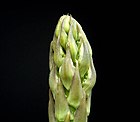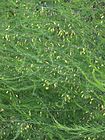Note: This is a project under development. The articles on this wiki are just being initiated and broadly incomplete. You can Help creating new pages.
Asparagus officinalis
Asparagus officinalis is a herbaceous perennial plant. It is having arching stems growing up from large underground rhizomes. It can grow up to 120cm tall. The plant is often cultivated on a commercial scale for its young shoots which are eaten in many countries of the world. The plant also has a wide range of traditional medicinal uses.
Contents
- 1 Uses
- 2 Parts Used
- 3 Chemical Composition
- 4 Common names
- 5 Properties
- 6 Habit
- 7 Identification
- 8 List of Ayurvedic medicine in which the herb is used
- 9 Where to get the saplings
- 10 Mode of Propagation
- 11 How to plant/cultivate
- 12 Commonly seen growing in areas
- 13 Photo Gallery
- 14 References
- 15 External Links
Uses
Jaundice, Congestive torpor of the liver, Urinary problems, Cancer, Lower blood pressure, Schistosomiasis.
Parts Used
Chemical Composition
Common names
| Language | Common name |
|---|---|
| Kannada | |
| Hindi | |
| Malayalam | |
| Tamil | |
| Telugu | |
| Marathi | |
| Gujarathi | |
| Punjabi | |
| Kashmiri | |
| Sanskrit | |
| English |
Properties
Reference: Dravya - Substance, Rasa - Taste, Guna - Qualities, Veerya - Potency, Vipaka - Post-digesion effect, Karma - Pharmacological activity, Prabhava - Therepeutics.
Dravya
Rasa
Guna
Veerya
Vipaka
Karma
Prabhava
Habit
Identification
Leaf
| Kind | Shape | Feature |
|---|---|---|
Flower
| Type | Size | Color and composition | Stamen | More information |
|---|---|---|---|---|
| {{{5}}} |
Fruit
| Type | Size | Mass | Appearance | Seeds | More information |
|---|---|---|---|---|---|
Other features
List of Ayurvedic medicine in which the herb is used
Where to get the saplings
Mode of Propagation
[[:Category:Index of Plants which can be propagated by |]]
How to plant/cultivate
Asparagus officinalis is a plant of mainly low elevations in the temperate zone, though it can also be cultivated at higher elevations from 1,000 metres up to 2,600 metres in the Tropics.[3]
Commonly seen growing in areas
Photo Gallery
References
External Links
- [ ]
- [ ]
- [ ]
- Ayurvedic Herbs known to be helpful to treat Jaundice
- Ayurvedic Herbs known to be helpful to treat Congestive torpor of the liver
- Ayurvedic Herbs known to be helpful to treat Urinary problems
- Ayurvedic Herbs known to be helpful to treat Cancer
- Ayurvedic Herbs known to be helpful to treat Lower blood pressure
- Ayurvedic Herbs known to be helpful to treat Schistosomiasis
- Herbs with Roasted seeds used in medicine
- Herbs with Young shoots used in medicine
- Habit - Perennial
- Index of Plants which can be propagated by
- Herbs that are commonly seen in the region of Fertile soils
- Herbs that are commonly seen in the region of Sandy soils
- Herbs
- Pages without herbs images






